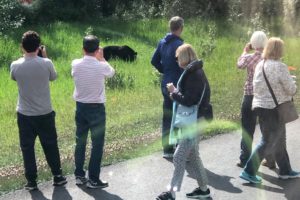Tourists vs Wildlife: A Growing Conflict

We are living in a time where everyone wants to get up close with wildlife to take photos and selfies. Many people use social media to show off their travels and photos need to be more spectacular then ever. In the search for the ‘perfect’ photo many people seem to completely ignore or forget about the wildlife viewing etiquette. Over the past ten years I have unfortunately witnessed people getting up close with bears, elk, moose, seals and other wildlife.
Getting too close to any wildlife will not only create stress for the animals and put people at direct risk of getting attacked, but will also cause animals to get habituated, and loose their fear for people. This will often led to the animals getting shot eventually to avoid further wildlife conflicts.
A quick 10 minute search on YouTube revealed a large number of videos of people that got to see the wildlife they were photographing from much closer then they had hoped for.
Bison charges girl in Yellowstone National Park
The first video posted here recently made global headlines. The video shows a number of people trying to pet a bison in Yellowstone National Park. A news article by CNN stated that approximately 50 people were standing 5-10 feet away from the animal that can reach a weight of up to 1,000 kg (2200 lbs). At the 0:05 mark of the video the bison accelerates and can be seen charging at a family. Despite their heavy weight these animals can reach speeds of up to 50 km (30 miles) an hour. The parents of the 9-year old girl can be seen abandoning the child and running for their own safety. The child gets thrown into the air after getting hit by the bison, while bystanders can be heard screaming in disbelief. Several media outlets reported that the girl was taken to a nearby medical clinic and later released.
Black bear runs after woman in Banff National Park
Sightings of people getting out of their vehicles and getting within meters of black bears and grizzlies have unfortunately become a daily sight along highway 93 in the Canadian Rocky Mountains. The 230 km highway that connects Lake Louise and Jasper is a popular tourist destination, as it features spectacular lakes, mountain views, and an abundance of wildlife. Because the highway does not feature wildlife fences like some of the other highways in the region, animals can often been seen directly beside the road. The video below shows an irritated black bear charging after a woman after it got surrounded by cars and people outside of their vehicles. Like many other people in the videos on this page, this lady is lucky to have survived her vacation in Canada!
Black bear charges group of tourists at Yellowstone National Park
Many animals become even more protective when they have young ones close to them. The video below shows a number of senior travelers ignoring close to every widlife viewing rule in the books. First of all they approached a mama bear with three cubs, instead of giving it the required space. The bears are furthermore on a bridge with a limited way out, potentially causing the bear to feel entrapped. After the mama bear starts walking after the tourists, they can be seen running away from the bear family with their backs towards the animals. It would have been better to slowly walk backwards and talk with a quiet voice, while constantly keeping an eye on the exact location of the animals. Again, these people were lucky to walk away from the encounter without getting harmed!
Elk attacks tourist in Banff National Park
Many National Parks throughout North America feature one or more animals belonging to the deer family. Elk, Moose, Caribou, and smaller species like the white-tale and mule deer are often seen on the edge of forests, beside (major) roads and in small towns. Some of these animals are social and tend to roam around in larger groups, while other like the moose live in solitary. More than any other animals in North America people seem to completely ignore the fact that getting hit by the head or antlers of one of these animals can cause major injuries or worse. An Asian newspaper reported back in 2018 that a record breaking 180 people were bit by deer in one of Japan’s National Parks. Although I wasn’t able to find any statistics for North America, attacks by mammals belonging to the Cervidae family frequently make the news.
Sea lion attacks young girl near Vancouver
The following video was recorded in the fishing village of Steveston, near Vancouver, BC. Although the video doesn’t show how many people are present on the dock, the audio suggests that a number of people are in close proximity to the animal. Around the 50 second mark a man can be seen pretending to be offering food to the sea lion. At 1:25 the animal shows the first signs of being agitated and tries to grab the little girl. This should have been a sign for the spectators to leave the animal alone to avoid further wildlife conflicts. A mere 15 seconds later the parents then allow the girl to sit right in front of the sea lion, which causes the sea lion to get up out of the water and drag the little girl into the water. A quick reaction of a bystander avoided worse, but this was another wildlife encounter that was entirely avoidable.
Parks Canada recommends the following minimum distances when viewing wildlife from outside of your vehicle:
- 100 metres from bears
- 30 metres from all other large species
- 200 metres from coyote, fox or wolf dens
